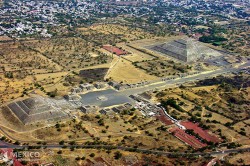Teotihuacan, Mexico.
Teotihuacán was believed to be the place where the gods created the universe, the name itself means "place where gods were born". This ancient sacred site is located approximately 50 km northeast of Mexico City and has become a popular side trip from Mexico City.
Teotihuacán was once a flourishing pre-Columbian city, it was constructed around 300 AD and was characterized by the vast size of its monuments that were carefully laid out on geometric and symbolic principles. Running through the middle of this vast archaeological complex is the Avenue of the Dead which connects its most monumental structures, the Temple of Quetzalcoatl, the Pyramid of the Sun (the third-largest pyramid in the world) and the Pyramid of the Moon.
The city was abandoned starting 700 AD for unknown reasons but it is believe the decline was cause by overpopulation and depletion of resources.
About 50 years after its abandonment, Teotihuacán was destroyed by fire, leaving some of its greatest monuments buried under millions of tons of earth. Its not know if it was deliberately burned by its former inhabitants, or by invaders.


Karnak Temple, Cairo, Egypt.
Dedicated to the pharaoh Amun, the temple complex of Karnak was the center of his worship and of his wife and son. The Karnak temple is a huge complex of over 25 temples and chapels built over a period of up to 1300 years of construction. About 30 successive pharaohs added their own touches to the temple during their reign.
It consists of four main parts, of which only the largest is currently open to the general public, the three other parts being the Precinct of Mut, the Precinct of Montu, and the dismantled Temple of Amenhotep IV.
The Temple of Amenhotep IV was purposely destroyed immediately after the death of its builder, pharaoh Akhenaton, who had attempted to overcome the powerful priesthood who had gained control over Egypt before his reign. It was demolished so thoroughly that its full extent and layout is currently unknown.
One of the most famous aspects of Karnak is the Hypostyle Hall in the Precinct of Amun-Re, a hall are of 5000 square meters with 134 massive columns arranged in 16 rows.


Carnac Stones, France.
The Carnac stones can be found around the village of Carnac, in Brittany, France and are a dense collection of megalithic sites consisting of alignments, dolmens, tumuluses and sigle mehirs (large upright standing stones). Carnac is believe to be the largest concentration of megalithic monuments in the world with over 100 monuments.
It is believe that the erection of the megaliths began somewhere around 4000 BC and may have continued for the next 2000 years. The Carnac stones consist of mainly three major groups of stone rows: Menec, Kermario and Kerlescan.
It is believe that they may have once formed a single group, but have been split up as stone were removed for other purposes. The original function of this megalith site as with others is still a mystery, some believe the Carnac stones had an astronomical function as a marker or foresight, while others think its an enormous cemetery.


Olmec Heads, Mexico.
The Olmec heads were sculpted from large basalt boulders and are a distinctive feature of the Olmec civilization of ancient Mesoamerica. There are at least seventeen of these monumental stone representations of human heads dated from at least before 900 BC. The Olmecs were extremely talented artists and sculptors, they were an important early Mesoamerican civilization that influenced the Aztecs and the Maya.
The Olmec heads all portray mature men with fleshy cheeks, flat noses, wide lips and slightly crossed eyes, the backs of the monuments are often flat and each of the known heads has a distinctive headdress. It has long been suggested that the stone heads represent warriors or chieftain leaders, or perhaps a ruling dynasty.
The boulders used to sculpt them were brought from the Sierra de los Tuxtlas mountains of Veracruz and were variously arranged in lines or groups at major Olmec centres due to their large size, the method and logistics used to transport the stone remains a mystery.


Puma Punku, Bolivia.
Translated to "The Doorway of the Puma", Pumapunku is a stone structure that's part of the larger Tiwanaku. It is best known for its massive stones and for the incredible precision of their cutting and placement. Puma Panku is one of those places where the stones are so closely fitted that a knife blade cannot be inserted between them. Many of the blocks are shaped into highly complex geometries. It is located southeast of Lake Titicaca in the Andes and it predates the Inca presence in that part of South America.
It is believed the site was constructed between approximately 500 and 600 AD, however early explorer Arthur Posnansky, one of the first modern explorers of the site, dated Puma Punku to about 15,000 B.C. The site is believed to have already been abandoned when the Incas conquered the area in 1470, though they spared no expense in incorporating Puma Punku and the rest of Tiwanaku city into their empire and culture.
The Incas believed the city was the place where Viracocha, their deity of creation, created the ancestral people of all ethnicities and sent them out into the world to populate their respective lands. The Incas also believe that the fallen stone portraits near Puma Punku were the models of the first humans from their creation myth, however, they are actually thought to depict the city's former rulers.

